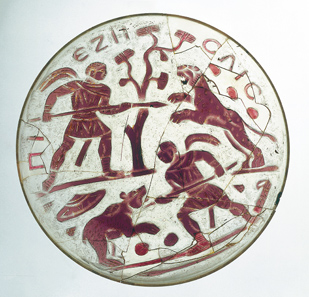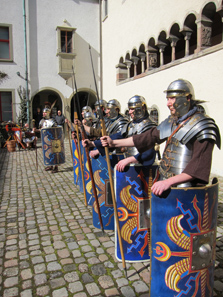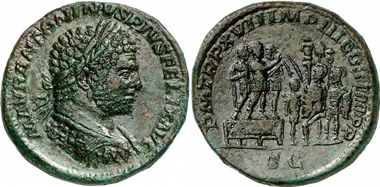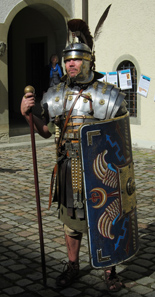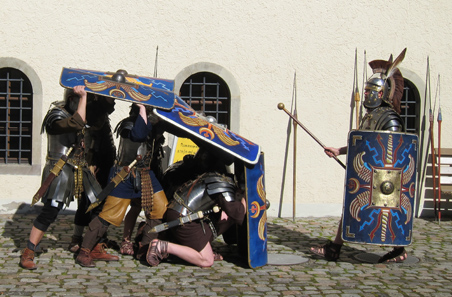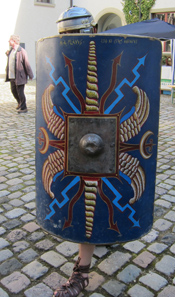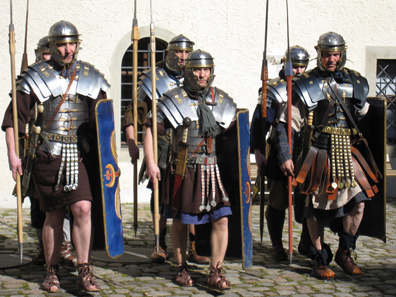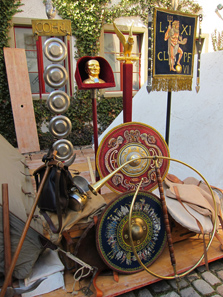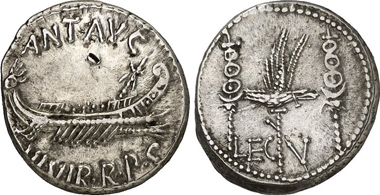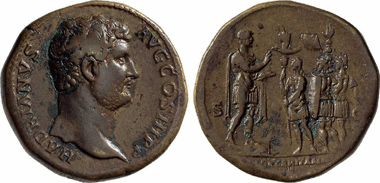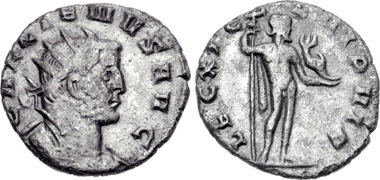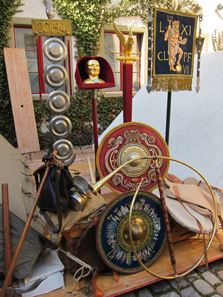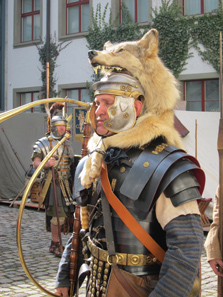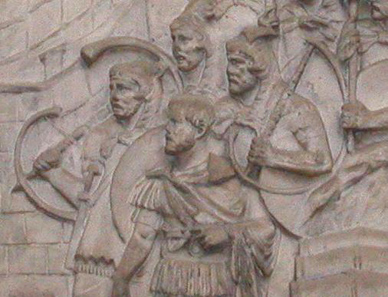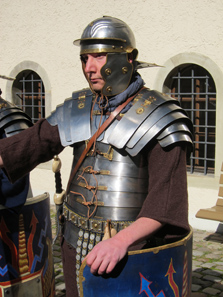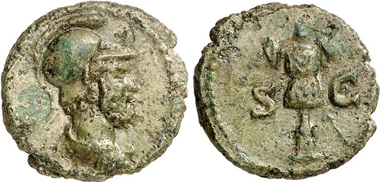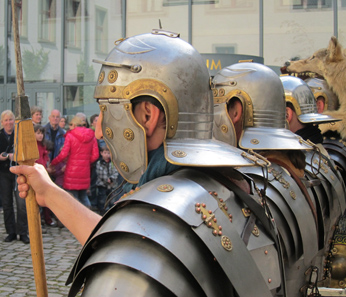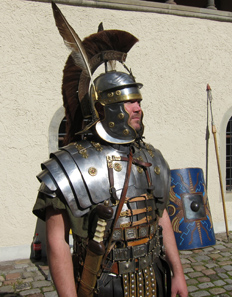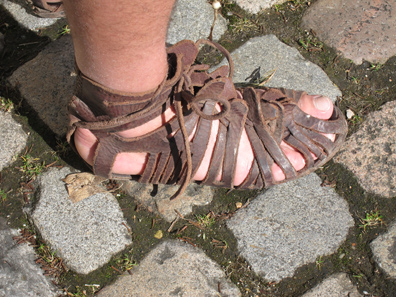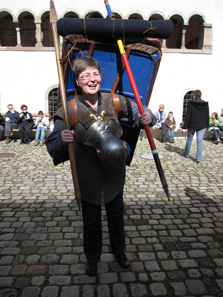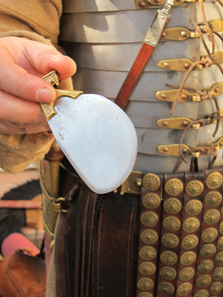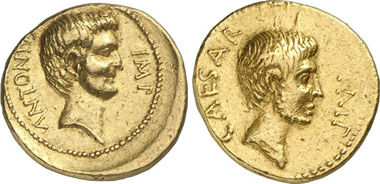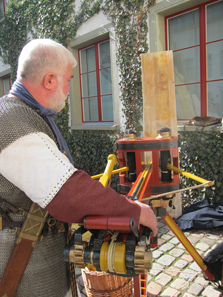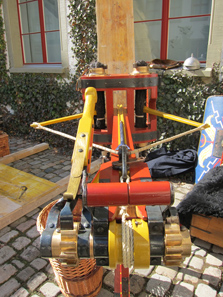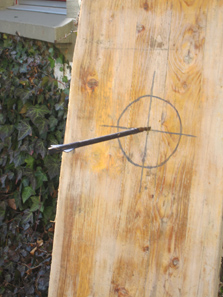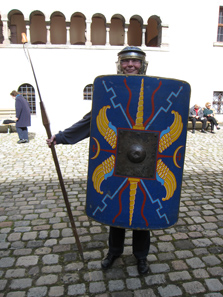Do you sometimes dream of visiting the epoch when Roman legions dominated the world, in the same way as the time traveller of H. G. Wells? Of course it is impossible, but modern re-enactment gives you quite a good idea of what the soldiers once accomplished.
Roman hunting cup from Stein am Rhein / Canton Schaffhausen. © Museum zu Allerheiligen Schaffhausen.
On Saturday, 10 March 2012 the last part of a permanent exhibition was opened in Schaffhausen. The exhibition, entitled “From the Stone Age to the Romans”, shows treasures from the Canton Schaffhausen, some of which date back until the Paleolithic.
Roman soldiers in the mediaeval abbey courtyard. Photo: UK.
The attraction of the opening were “real” Romans. A detachment of Legio XI Claudia Pia Fidelis had come. They exercised and gave explanations. And what you could learn was incredibly exciting.
Caracalla, Sestertius, 214. Rv. Caracalla standing on a platform with two officers speaking to soldiers with standards. From Gorny & Mosch auction 180 (2009), 412.
Soldiers seem to appear quite often on coins. But when you look closer you become aware of the fact that mostly they are officers depicted together with the emperor. As for the common soldier’s equipment coins give but rare hints.
Optio ad spem: Troop member of the highest rank. Photo: UK.
Hence let’s begin here as well with the present officer of the highest rank, the optio ad spem which means an optio expecting his promotion to centurio. The centurio was the acting commander of a group of one hundred soldiers (not even during the Republic they used to reach the required strength), the optio ad spem was his deputy. Instead of sumptuous phalerae he had a cane adorned with a sphere as symbol of his command …
Testudo. Photo: UK.
… and to test whether the tortoise formation was perfectly successful and everybody is handling his shield well.
Yet the shield is a real weapon by itself. Photo: UK.
Yet the shield. It’s a real weapon. The soldier uses it not only for hiding but as a screen behind which he can prepare his attack. And the metal reinforced edge is very helpful if you wish to break one’s shin.
Principal attacking weapon is the short sword. Photo: KW.
Anyway, the principal attacking weapon is the short sword, which is not made to chop but to pierce.
none
These are not spears but pila, Roman javelins. Photo: KW.
In addition every Roman soldier had his pilum, a special kind of javelin. Its primary intention was not to kill the enemy but to pierce into the enemy’s shield in such a way that he had to drop it. Even though in the time of the Roman Republic soldiers occasionally had two pila, our legionaries have only one. This is because their epoch is the first century AD. It is very important for re-enactment groups to limit themselves to a precise time frame whose equipment they re-enact. Our troop has chosen the Flavian time.
The sanctuary of Legio XI. Photo: UK.
Thus, in the legion’s sanctuary you can see the portrait of Vespasianus.
Marcus Antonius. Denarus, 32-31. Rv. Eagle between two military standards. From Gorny & Mosch auction 204 (2012), 2053.
On the left – on this coin on the left and right – there is the military standard, signum, on the right the aquila, the eagle standard of the legion which is shown in the centre of the coin. And in the sanctuary we can see below the circular shield belonging to the equipment of the aquilifer, the standard bearer.
Hadrianus. Sestertius, 137. Rv. Hadrianus in a gesture of speech in front of representatives of the British army. In front the aquilifer with the legion’s eagle standard wearing a wolf-skin cap on his head. From Lanz auction 94 (1999), 504.
This coin of Hadrian does not only show the aquilifer but the bearers of signum and vexillum as well, thus of the smaller standards that appear on the extreme right of the photo. Let’s sort it out precisely: the eagle was the standard of the legion, the signum belonged to the manipulum (corresponding to two centuriae), the vexillum was given to legion detachments instead of the legion’s standard becoming hence closely associated with the name of such a detachment, called a vexillatio. Oh, and naturally the Legio XI fits in perfectly from the geographical aspect. Because this unit created by Caesar was installed at Windisch as successor of Legio XXI Rapax in 70/71 AD. Its mascot was Neptunus and he is really attractive.
Gallienus. Antoninianus, Milan, 260/2. Rv. LEG XI C L VI P VI F Neptunus. From CNG auction 87 (2011), 1121.
It is also due to coins that we know that Neptunus was the mascot of Legio XI.
The sanctuary of Legio XI. Photo: UK.
By the way, if you look attentively you will recognize a chest in the sanctuary. There the legionaries’ savings were kept.
The cornicen: signaller in combat. Photo: UK.
And now back to our soldiers. Here we see another important junior officer, the cornicen, responsible for transmitting signals. He wears – like the signifer – a wolf-skin cap,
Detail from Trajan’s Column. Source: Wikipedia.
… that can be seen clearly on Trajan’s column.
Legionary. Photo: UK.
Let’s leave the junior and senior officers. Let’s go to the common troop. Here we see a legionary in full combat equipment with helmet and armour.
Quadrans, 120-150. Head of Mars. Rv. Trophy. From Gorny & Mosch auction 204 (2012), 2223.
Roman coins simply do not prepare us regarding of how well a helmet protects the head.
Legionaries. Photo: UK.
A broad neckguard with space for the ears cut out to make you hear the commands …
Basically the optio wears the same helmet as the legionaries. Photo: UK.
… curved cheekpieces because only with a bigger cutout for the eyes the legionary can see if he keeps still in line. The crest, by the way, is part of the dress uniform. In combat, however, this would be only hindering.
Legionary sandals. Photo: UK.
And in these sandals legionaries crossed Europe, Asia and Africa.
Peter Jezler, director of the museum, wearing a legionary’s field pack on his back. Photo: KW.
Have you ever thought about what these poor soldiers had to carry around?
The author of this article would not even make 100 metres with this luggage. Photo: KW.
Around 30 kg weights a legionary’s field pack consisting of his clothes, mail shirt (that we were kindly allowed to wear), helmet, shield, pilum, and whatever you needed. After I tested it by my own, I can assure you that I would not even have made 100 metres with all that stuff. And when, in future, I will read of Caesar’s forced marches I will simply shrug it off as mere propaganda.
Field pack of a legionary. Photo: UK.
This makes the field pack: Cooking pot, helmet crest, …
Field pack of a legionary. Photo: UK.
entrenching tools (the axe), toilet paper (the bar with the sponge), provision for three days …
Legionary’s favourite meal. Photo: UK.
… which consists of grains of wheat.
Roman puls. Photo: UK.
With those one can prepare the Roman kind of porridge, the famous puls. And it even tastes quite good. At least, you can become accustomed to it.
Roman razor blade. Photo: UK.
However, according to legionaries’ statements shaving with the once used razor blades was much less comfortable. Since, 2000 years ago, there was only olive oil available for skin care, only the fewest in the camps will have cared much for a nice shave.
Octavianus, Aureus, 39. Head of Marcus Antonius. Rv. Head of Octavianus as commander with stubbles. From Gorny & Mosch auction 203 (2012), 311.
No wonder on coins commanders figure very often with stubbles to show that when campaigning they could not spare the time for the time consuming procedure of shaving.
The ballista, a sort of standing crossbow. Photo: UK.
Happy whoever enlisted again after 25 hard years, might have stood then in service behind the ballista. Handling this extremely efficient tool he stood behind the lines and did not have to carry the device himself because it was transported on a carriage.
Ballista with loaded bolt. Photo: UK.
But, however, it is very effective in combat. Since when two persons handle this ballista they were able to shoot up to 12 bolts a minute. And once this weapon is adjusted …
A bolt in the target. Photo: UK.
… it always hits exactly the same place as the first shot.
none… it always hits exactly the same place as the first shot.
Photo: KW.
Well, did I promise too much? Was this a travel through time? And whoever wants to join in or admire the Legio XI in action should visit their homepage.
Furthermore you can find a video clip about the Legio XI on Youtube.
And for those who would like to try making some puls at home, you can find a receipt here.





